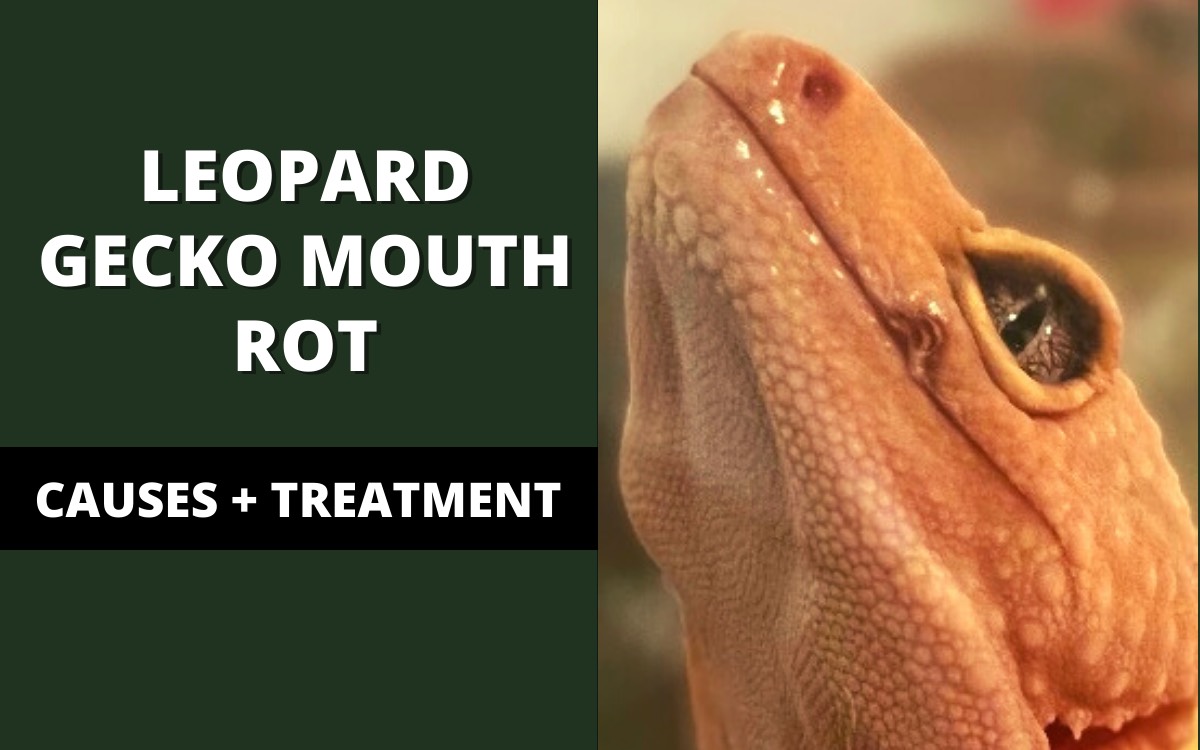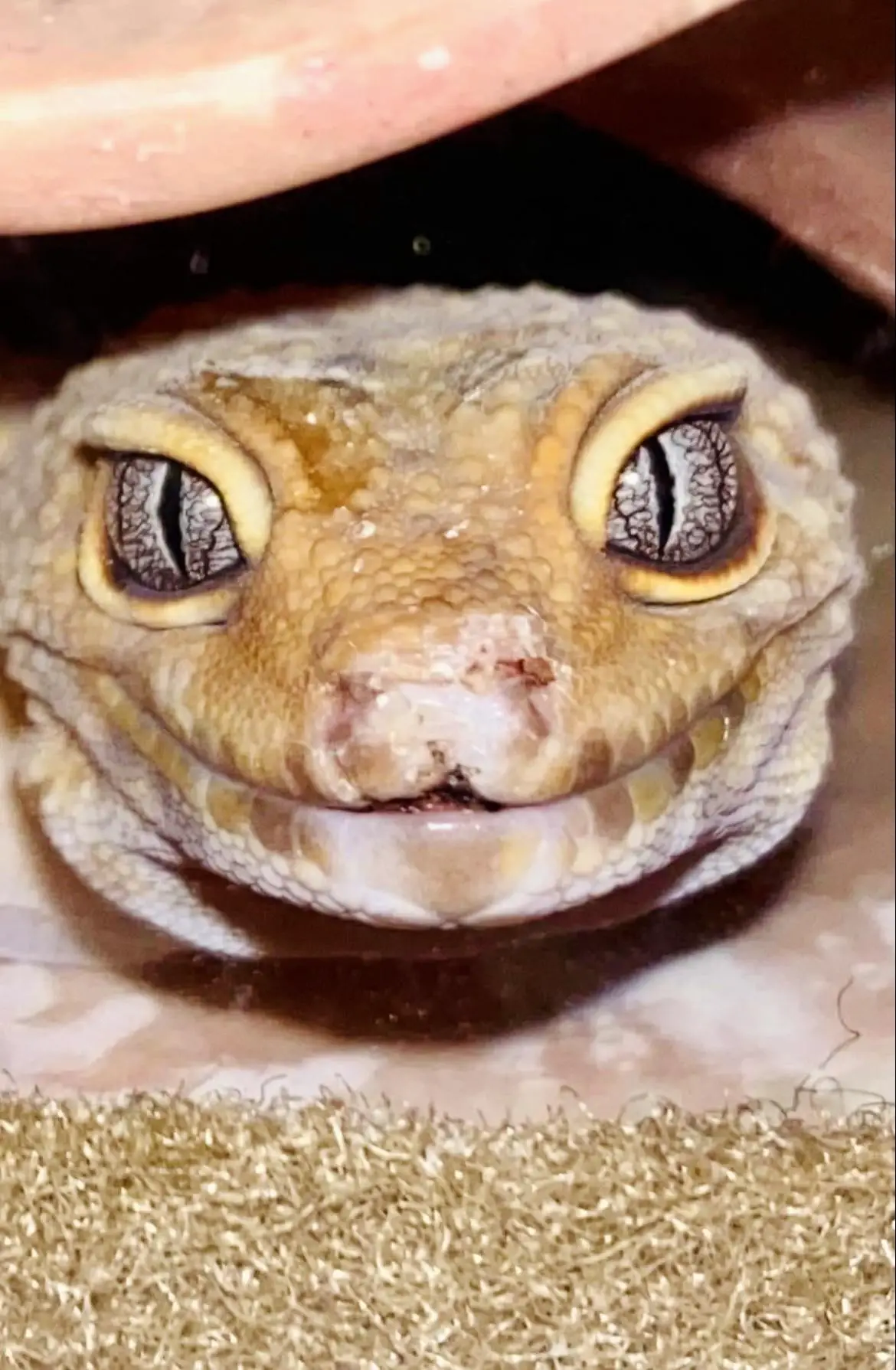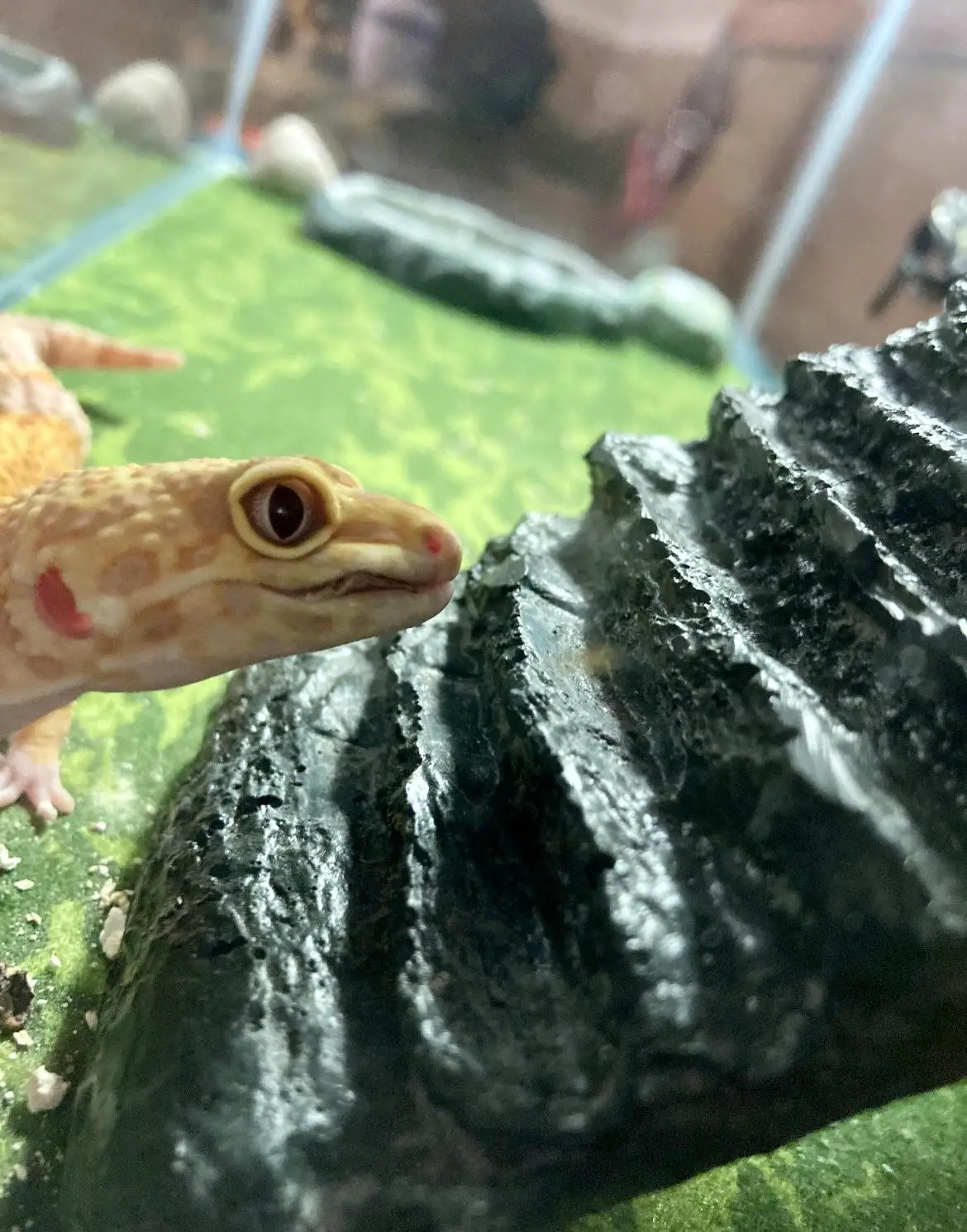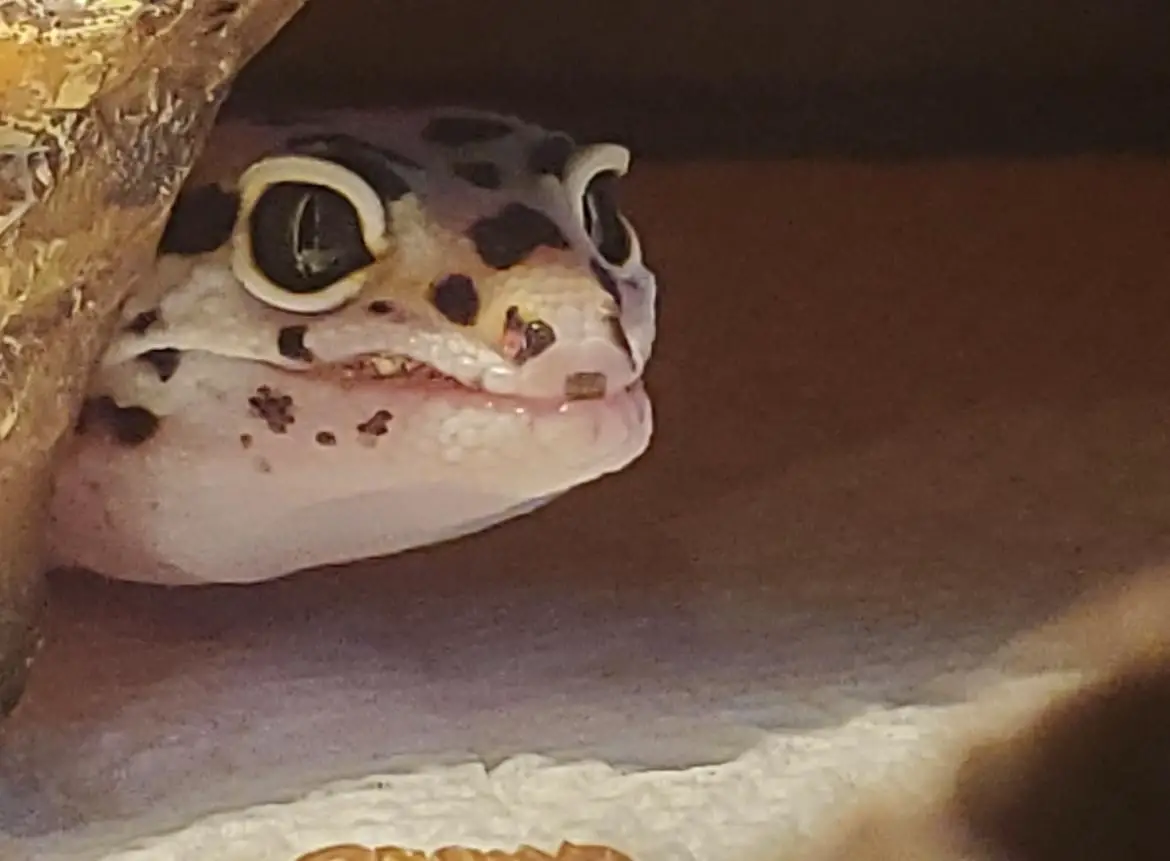Disclaimer: As an Amazon Associate I earn from qualifying purchases. Therefore, we may collect a share of sales from the links on this page, at no extra cost to you!

Did you know that there are over 1,500 different species of leopard geckos? They come in a variety of colors and patterns, making them one of the most popular reptile pets. They’re also easy to care for, and make great first-time pets for children.
Unfortunately, even with the best of care, leopard geckos can develop mouth rot – a serious and potentially fatal infection. In this article, we’ll take a look at what causes mouth rot in leopard geckos, how to identify it, and the best ways to treat it.
Jump to..
What is Leopard Gecko Mouth Rot?

Mouth rot, or stomatitis, is an infection of the mouth caused by bacteria. It can be very serious and potentially fatal if left untreated. This infection usually occurs in the lower jaw where the teeth are located. If your gecko has mouth rot, their gums may be swollen, red, and ulcerated. They may also have problems eating or drinking due to the pain caused by the infection.
What Causes Leopard Gecko Mouth Rot?

The exact cause of mouth rot in geckos is not clear, but it can occur when the animal’s immune system is weakened due to poor husbandry or other health issues. Inadequate temperatures, humidity levels, or nutrition can all contribute to a weakened immune system and make your leopard gecko more susceptible to mouth rot.
Some of the most common causes in leopard geckos include:
- Poor husbandry (incorrect temperatures, humidity, or nutrition): During a health checkup, your vet will assess the humidity and temperature levels in the enclosure to determine if these might be contributing to your gecko's mouth rot.
- Injuries: If your leopard gecko has suffered an injury that resulted in a cut or scrape on their gums, this can lead to an infection. As they heal, they may develop mouth rot.
- Stress: Stress can weaken your gecko's immune system, making them more susceptible to bacterial infections like mouth rot. For instance, a sudden change in the environment or the introduction of new animals can cause stress.
- Parasites: Parasites such as mites or ticks can lead to an infection if they are allowed to remain on your leopard gecko's body. Your vet will examine your gecko for any parasites during the health checkup.
- Other illnesses or infections: If your leopard gecko has another illness or infection, their immune system may be weakened and they can become more susceptible to mouth rot.
How to Identify Mouth Rot in Leopard Geckos

The most obvious symptom of leopard gecko mouth rot includes swelling and redness of the gums. You may also notice that your leopard gecko is having difficulty eating or drinking, and their mouth may be covered in yellowish or white discharge.
If you suspect that your leopard gecko has mouth rot, it’s important to take them to the vet immediately for a health checkup. Your vet will examine your gecko and perform any necessary tests to diagnose the infection.
Here are a few symptoms that may indicate mouth rot in leopard geckos:
- Swollen or red gums: When examining your leopard gecko's mouth, you may notice that their gums are swollen and red.
- Difficulty eating or drinking: If your leopard gecko is having difficulty chewing, swallowing, or drinking, this could be a sign of mouth rot.
- Yellowish or white discharge: You may also see yellowish or white discharge in their mouth, which could be a sign of an infection.
- Bad breath: If your leopard gecko is exhibiting any of these symptoms, they may also have bad breath.
How to Treat Leopard Gecko Mouth Rot
If your leopard gecko has been diagnosed with mouth rot, the best course of action is to take it to an experienced exotics or reptile veterinarian for treatment.
The vet may prescribe antibiotics in the form of injections, topical treatments, oral medications, or a combination of the three. It’s important to follow the vet’s instructions carefully and make sure your gecko completes the entire course of treatment so that its mouth rot doesn’t come back.
In addition to veterinary care, there are a few things you can do to help treat your leopard gecko’s mouth rot:
#1. Provide Plenty of Fresh Water.
The best way to prevent mouth rot is to give your gecko plenty of fresh water. Make sure it always has a clean bowl of water available, and change the water regularly. When changing the water, check for any signs of infection and contact your vet if you see anything suspicious.
Since leopard geckos are prone to dehydration, mist the cage with water several times a day. This will keep your gecko’s skin hydrated and help prevent mouth rot.
#2. Feed a Healthy Diet.
A well-balanced diet is essential for keeping your leopard gecko healthy and preventing infection. Make sure you feed your gecko a variety of fresh fruits and vegetables, as well as insects or worms. Avoid feeding it processed foods or anything containing high amounts of sugar, which can lead to infections.
Even if your gecko is suffering from mouth rot, it still needs to eat. Speak to your vet about what foods are best for your leopard gecko during treatment.
#3. Keep the Enclosure Clean and Sanitized.
Another key factor in preventing and treating mouth rot is keeping a clean and sanitary environment for your leopard gecko. Clean the cage and surrounding area regularly, and use a reptile-safe disinfectant to help kill germs and bacteria.
Make sure the temperature of the enclosure is between 75 and 85 degrees Fahrenheit, as this will create an environment conducive to healing.
#4. Increase Humidity in the Cage.
It’s important to keep the air in your gecko’s habitat humid enough for it to stay healthy, which may help prevent mouth rot from occurring in the first place. You can increase humidity by misting the cage several times a day and using a reptile-safe humidity gauge to monitor levels.
#5. Consult With Your Vet.
If you suspect that your leopard gecko has mouth rot, it’s important to contact a veterinarian right away. They will be able to diagnose and treat the infection appropriately and provide advice on how to prevent future infections.
If your leopard gecko does develop mouth rot, you should take it to an experienced veterinarian for treatment. In addition to veterinary care, providing plenty of fresh water, feeding a healthy diet, keeping the enclosure clean and sanitized, and increasing humidity can all help to treat and prevent mouth rot.
Best Practices to Avoid Leopard Gecko Mouth Rot
If you are a leopard gecko owner, you certainly want to avoid mouth rot. Knowing the causes and symptoms of this disease can help you better understand what needs to be done to keep your reptilian friend healthy.
Here are a few best practices for avoiding leopard gecko mouth rot:
- Ensure proper hydration: Leopard geckos are prone to mouth rot if they are dehydrated. It is important that you provide your leopard gecko with ample water and check the hydration level of its enclosure regularly. Since geckos do not need to drink standing water, you can use a shallow dish or water bowl for them to lap up the liquid.
- Provide an appropriate environment: Leopard geckos should be kept in an enclosure that is neither too cold nor too hot. The temperature and humidity of the habitat should also be closely monitored and adjusted as needed. It is also important to ensure that the enclosure is clean, as dirt and debris can contribute to mouth rot.
- Avoid overcrowding: Leopard geckos should not be kept in overcrowded habitats, as this may lead to stress, which can lead to a weakened immune system and increased risk of disease. Most experts recommend that leopard geckos should have at least 10 gallons of space per gecko.
- Provide the right diet: Leopard geckos need a balanced and nutritious diet to stay healthy. You should provide them with plenty of insects such as crickets, mealworms, wax worms, and super worms. Live food items should be dusted with calcium and multivitamins.
- Handle your leopard gecko correctly: When handling your leopard gecko, it is important to be gentle and avoid stressing the animal out. Too much stress can weaken the immune system and leave them vulnerable to mouth rot.
- Monitor for signs of illness: It is important to monitor your leopard gecko for signs of illness and take them to the vet if needed. Early detection and treatment is key in preventing mouth rot from getting worse.
- Clean the enclosure regularly: Leopard geckos should have their enclosures cleaned regularly to prevent the buildup of bacteria and fungus, which can lead to an increased risk of mouth rot.
- Quarantine any new geckos: If you are introducing a new leopard gecko to your existing animals, it is important to quarantine them for at least two weeks to ensure that they do not have any contagious diseases such as mouth rot.
By following these best practices, you can help keep your leopard gecko happy and healthy.
Final Thoughts on Mouth Rot
Leopard gecko mouth rot is an infection caused by bacteria and fungi that can be serious if left untreated. Knowing the causes, symptoms, and best practices for avoiding mouth rot is essential for any leopard gecko owner. If you suspect that your leopard gecko has developed mouth rot, contact a veterinarian right away so they can diagnose and treat the condition.
With proper care and treatment, your leopard gecko can make a full recovery. Keeping your leopard geckos healthy is an important part of keeping them happy, so make sure to follow these tips for avoiding mouth rot.
FAQs
Is Leopard Gecko Mouth Rot Fatal?
Like all living things, leopard geckos can sometimes fall ill. One potential health problem is known as mouth rot, which is caused by bacteria that infect the gums and teeth. If left untreated, mouth rot can cause severe damage to the oral tissues and even lead to death. However, with prompt veterinary care, most leopard geckos make a full recovery.
Still, it’s important to be aware of the signs of mouth rot so that you can seek treatment for your gecko as soon as possible. Symptoms include excessive drooling, pus around the mouth, and Difficulty eating. If you notice any of these signs, take your gecko to the vet right away. With early intervention, your pet will have a much better chance of making a full recovery.
How Do You Treat Reptile Mouth Rot at Home?
The first step is to clean the affected area with a mild disinfectant. You can then apply a topical antifungal cream or ointment to the area. If the mouth rot is severe, you may need to give your reptile oral antifungal medication. It’s also important to boost your reptile’s immune system during treatment. This can be done by offering them a variety of healthy foods and supplements.
How Do You Rehydrate a Leopard Gecko?
A gecko is a type of lizard that is native to warm climates. These creatures are very sensitive to dehydration, and their bodies are not very efficient at storing water. As a result, it is important to provide them with a source of fresh water at all times. The easiest way to rehydrate a gecko is to place it in a container of lukewarm water.
The gecko will drink the water and absorb it through its skin. It is important to supervise the gecko during this process, as they can drown if left unattended. Once the gecko has had a chance to drink and soak, it should be placed back in its enclosure. With proper care, a gecko can stay healthy and hydrated for many years.
How Do You Open a Leopard Gecko's Mouth?
Have you ever tried to open a leopard gecko’s mouth? It’s not as easy as it sounds! If you’ve never done it before, here’s a quick guide. First, hold the gecko’s head gently in your hand. Then, using your other hand, carefully insert your finger into the corner of the gecko’s mouth.
Once you’ve located the jaw muscle, apply gentle pressure and slowly pull the mouth open. If you do it correctly, you should be able to see the gecko’s teeth. Just be careful not to put your finger too far back, or you might get bitten! With a little practice, opening a gecko’s mouth will become second nature.
